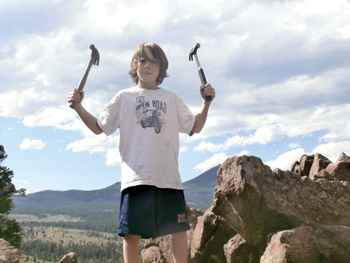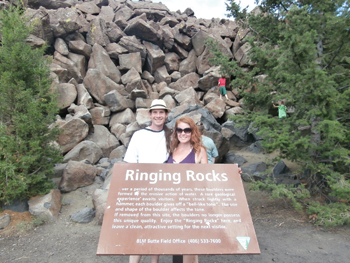The Ringing Rocks Phenomena
Thursday Aug. 1st, 2013
High on the southwestern flank of Dry Mountain, off the I-90 Pipestone Exit 241, 15 miles east of Butte America in Jefferson County, there is a rough, winding dirt road that leads to the natural, ethereal phenomena; The Ringing Rocks.
Cows grazed freely and wandered undisturbed paying us no mind as we crawled past the colorful blooming Wild Cactus spotting the areas next to the road as we made our way toward the Ringing Rocks. The sound of the dreaded pine beetles’ chirp echoed loudly in our ears as we made the slow ascent to witness the legendary landmark and added to the anticipation of this long awaited visit. The occupants of our vehicle noted that the five mile trek from the main road seemed much further, but one supposes that, only able to go twenty miles per hour or less, it makes complete sense. Washboard roads and rocky terrain are prevalent, though we did see several vehicles make the trip without the benefit of four wheel drive, and with no apparent difficulty. And, aside from having to back out of a stretch of one lane road to let a convoy of out going vehicles pass, along with a stomach churning steep drop off on one side, we had no problems with the trip either. There is a parking area below the last steep stretch of road that completes the journey, and we made the decision to park and walk, as to not have to turn our extra long Suburban around in the tight parking area adjacent to the landmark. Grabbing our hammers and some much needed water, we set out to make some rocks ring. Several people were navigating the steep terrain on foot as well, though they were trudging through the rocks and sage brush down the side of the hill as we made our way up the road, and I wondered if they were from Montana, and if they were fully aware that those are the kind of conditions in which the deer tick likes to reside. Finally, we rounded a curve at the top of the hill, the road ended and the Ringing Rocks came into sight. We had arrived!
Boulders of all shapes, sizes and colors pile high on one another towering into the vast blue sky. Seemingly placed upon one another, like a wall or a giant fence, these boulders were actually formed by the erosive action of water over a period of thousands of years. A metal placard stands in front and states that the Ringing Rocks are a “rare geological experience” and when each individual rock is struck lightly with a hammer, that they will produce a “bell-like tone”. Each one of these tones is as different as the rocks themselves. Our group splits up and begins to hammer out some sounds, listening intently to all the other tones that were being produced all around us by others, and commenting on what they sounded like. “Oh, that one sounds like a train whistle”, and “that one sounds like a bell ringing”. The braver of heart scaled the rocks and climbed high with their hammers, finding the rocks less hammered on, while the majority stayed closer to the terra firma and belted out tunes on the lower rocks. There are, however, trails that go around and up the back side of the formation, and lead to the higher areas without the death defying monkey climbing, and entailing the hiker to, well, hike.
Our willing and experienced guide, Don Michalsky, a Butte native, and a veritable expert on the best places to see off the beaten path in and around Butte, had to field several questions from my reporter persona. ‘When were the Ringing Rocks first discovered?’ ‘When did they turn it into a tourist attraction?’ ‘What are the geological forces that caused this to happen?’ He was patient and seemingly amused and answered all of my inquiries as best he could.
According to sources such as Mr. Michalsky and Wikipedia, among other reports, the technical geology of the area breaks down like this: The Ringing Rocks were established as a recreation area by the US Bureau of Land Management in 1964. The tor of boulders is the deep-seated vent for an ancient volcano that erupted 76 million years ago. This pluton is a perfect example of magma mixing in a conduit, specifically between olivine basalt and granite magmas, and the mixing of the magmas created a curious hybrid rock type which crystallized against the outer wall of conduit. Millions of years of uplift and erosion followed and the thin walls of the hybrid rock were exposed to the surface. Periglacial freezing during the Pleistocene Epoch slowly shattered the high standing walls, much like breaking tempered glass, to form a gigantic tor. It has a diameter of one kilometer, and is highly symmetrical. The overall geometry is cylindrical. If you happen to be a Geology nut, as many people that I have known are, hailing from the great institution of Montana Tech, I would highly suggest checking out the information on Wikipedia, as there is a plethora of great technical information that would most likely put the regular reader into a tail spin.
Our visit to the Ringing Rocks was a great way to spend an afternoon with the family without having to drive too far away from the city, and is not only informative and educational, but a hands on, fun time for kids of all ages. One story that I found most interesting is that at one time, there was a back hoe brought up to move some of the rocks to another location to create the same phenomena elsewhere. The rocks were gathered, moved, and to the chagrin and surprise of the movers, did not produce any sound once moved. The rocks only make music in the spot that they currently reside.
If you make a trip to the Ringing Rocks remember, bring your sunscreen, water, and make sure you don’t forget you hammer.
Stacey Faldetta is a freelance writer currently living in MT with her four children. She is working on her first book of compiled poetry called ‘A Thousand Little Sparks’ and enjoys travelling extensively around our breath taking state enjoying all that the Big Sky Country has to offer. She can be reached at mtcinnamon73@gmail.com
| Tweet |